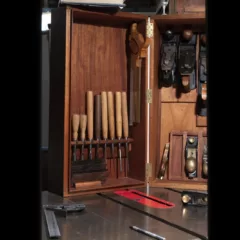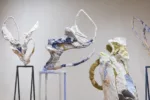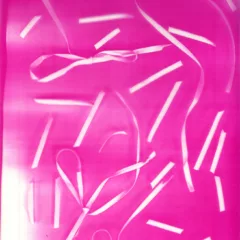There’s a wonderful double feature of Winifred Lutz’s work at the Abington Art Center through November 25, 2012. Titled Between Perception and Definition, one part fills three galleries indoors, the other is sited in the area of the grounds that was formerly the pool and cabana. Both confirm a deep study of nature, although none of the work attempts a realistic portrayal of actual natural forms.
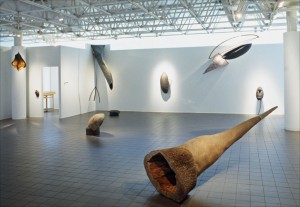
The first, high-ceilinged gallery is hung as an installation, although each element is also an individual work, with a title, and some of the pieces are dispersed among various collections.Lutz has re-done the gallery’s interior to create a seamless background for her biomorphic forms that float in space, protrude from walls or lean against them; a few sit on small shelves that cantilever from the walls. Surely they are the remains of living creatures, and we are viewing their cast-off pods and carapaces at the scale that small insects must view the world we normally inhabit.
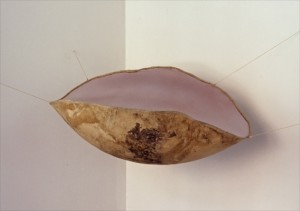
The magical and un-forced naturalism of the work is undisturbed by several bits of man-made objects, such as the pulley for a laundry line that seems to have been partially ingested by a log. A wall-hung table case holds a fold-out book and a number of drawings, mostly studies of details of Lutz’s alternative world, which is as complex and detailed as our own. She makes the range of dulled browns, greys and beiges she employs seem both lush and sufficient. I want to know the materials she uses (the exhibition was lacking labels when I visited). When I discover that most of it is hand-made paper, and Lutz describes the method she uses to create three-dimensional forms, it does nothing to explain the range of textures, apparent range of density and surfaces that her artistry evokes. This is definitely work that screams touch me, caress me!
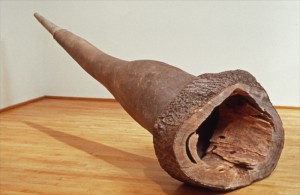
Even the wall-hung pieces that are clearly made of paper hang, or rather appear to float, in a manner unlike any paper I have seen. Neither matted nor framed, they are hung on mounts that suspend them away from the wall, and sometimes are anchored with string. Even these mounts appear organic; every corner and edge has been accounted for. They have a sensitivity to detail that I associate with Japanese craftsmanship. Some of Lutz’s hand-made paper is transparent, other sheets have windows cut into them with something visible behind. These create the same sense of discovery that Lutz sets up in the sculptures which also function as a camera obscura or an optical device. Her large, three-dimensional work has a sensibility related to that of Martin Puryear, but these suspended paper works remind me of nothing else.
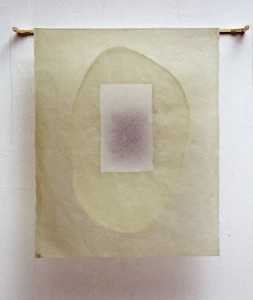
The works in the gallery with one gold-leaved wall are so sensitively placed that I assumed at least one had been created for that location (it was not). Two of these large pieces are meant to direct one’s vision to phenomena that Lutz has framed within them. Don’t miss looking up into the piece which resembles an elephant’s trunk, poking through a wall. This is only one of Lutz’s almost magical effects. More are to be found in Once Was, a project Lutz worked on with five assistants who did the back-breaking work of excavating the abandoned swimming pool and cabana of the original Rosenwald estate, that had been subsumed by forest.
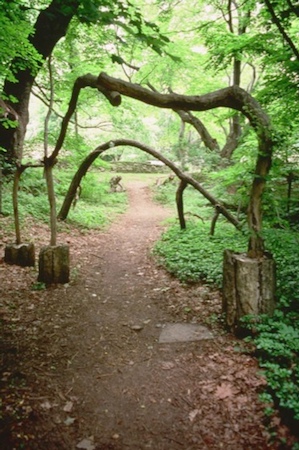
oI suggest walking through the garden before reading about it, because discovering Lutz’s interventions is part of the pleasure. I won’t give it away here. The forest overgrowth reminds me of pictures I have seen of Angkor Wat, where roots and branches grow around and through the temple. One discovers Lutze’s hand in the details that are regularized: stones moved, sticks piled, and ephemeral sculptures of twigs, which have been sited within the forest growth. These last are my favorite, because of their element of surprise.
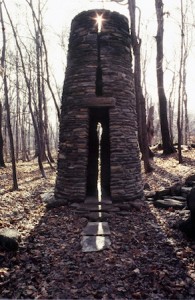
On leaving the garden I looked to my right, at the remains of a vine crawling over lattice. Part of the withered foliage had stalks that were bent, and to this day I’m not sure whether I was looking at a natural phenomenon, or one more bit of Lutz’s magic. And that’s the point, isn’t it? Her work frames the mysteries that she found in the forest itself.
A monograph on the artist is being published in connection with the exhibition; it will have essays by Janet Koplos, Richard Torchia, Mina Takahashi and Carol Franklin.



